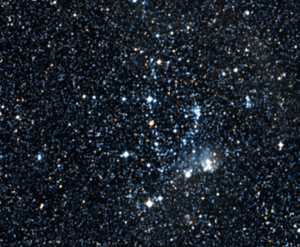Astronomy:HV 888
| Observation data Equinox J2000.0]] (ICRS) | |
|---|---|
| Constellation | Dorado (LMC) |
| Right ascension | 05h 04m 14.116s[1] |
| Declination | −67° 27′ 06.40″[1] |
| Apparent magnitude (V) | 11.57[2] |
| Characteristics | |
| Evolutionary stage | Red supergiant |
| Spectral type | M4 Ia[3] |
| Apparent magnitude (K) | 6.781[4] |
| Apparent magnitude (U) | 15.876[4] |
| Apparent magnitude (B) | 13.949[4] |
| Variable type | SRc[3] |
| Astrometry | |
| Radial velocity (Rv) | 291.53[1] km/s |
| Proper motion (μ) | RA: +1.773[1] mas/yr Dec.: +0.049[1] mas/yr |
| Parallax (π) | 0.0079 ± 0.0173[1] mas |
| Distance | 50,000[5] pc |
| Details | |
| Mass | 25[6] M☉ |
| Radius | 1,353–1,584; 1,374 R☉ |
| Luminosity | 302,000+29,000 −27,000[7] (190,000[8] – 527,000[5]) L☉ |
| Surface gravity (log g) | +0.5[5] cgs |
| Temperature | 3,442[6]–3,500[5][9] K |
| Other designations | |
| Database references | |
| SIMBAD | data |
HV 888, also known as WOH S140, is a red supergiant (RSG) star located in the Large Magellanic Cloud.[10] It is possibly among the largest known stars, with reliable estimates of its radius ranging from 1,353 R☉ to 1,584 R☉,[11][12] and is also one of the most luminous of its type with a range of nearly 300,000 to over 500,000 times that of the Sun (L☉).[13][9][7] The effective temperature is estimated to be around 3,500 K.[5] If placed at the center of the Solar System, its photosphere would engulf the orbit of Jupiter.
The apparent magnitude of HV 888 is variable, with an amplitude of 0.59 magnitudes around a mean value of about 11.57.[2] It is classified as a semiregular variable of type SRc indicating a cool supergiant.[3] Variations in its radial velocity have led to the suggestion that it is a binary.[14]
See also
References
- ↑ 1.0 1.1 1.2 1.3 1.4 1.5 Vallenari, A. et al. (2022). "Gaia Data Release 3. Summary of the content and survey properties". Astronomy & Astrophysics. doi:10.1051/0004-6361/202243940 Gaia DR3 record for this source at VizieR.
- ↑ 2.0 2.1 "LMC V0852". AAVSO. https://www.aavso.org/vsx/index.php?view=detail.top&oid=76921.
- ↑ 3.0 3.1 3.2 Samus, N. N. et al. (2009). "VizieR Online Data Catalog: General Catalogue of Variable Stars (Samus+ 2007-2013)". VizieR On-line Data Catalog: B/GCVS. Originally Published in: 2009yCat....102025S 1: B/gcvs. Bibcode: 2009yCat....102025S.
- ↑ 4.0 4.1 4.2 Bonanos, A. Z.; Massa, D. L.; Sewilo, M.; Lennon, D. J.; Panagia, N.; Smith, L. J.; Meixner, M.; Babler, B. L. et al. (2009). "Spitzer SAGE Infrared Photometry of Massive Stars in the Large Magellanic Cloud". The Astronomical Journal 138 (4): 1003–1021. doi:10.1088/0004-6256/138/4/1003. Bibcode: 2009AJ....138.1003B.
- ↑ 5.0 5.1 5.2 5.3 5.4 Groenewegen, M. A. T.; Sloan, G. C. (2018). "Luminosities and mass-loss rates of Local Group AGB stars and red supergiants". Astronomy & Astrophysics 609: A114. doi:10.1051/0004-6361/201731089. Bibcode: 2018A&A...609A.114G.
- ↑ 6.0 6.1 Ren, Yi; Jiang, Bi-Wei (2020-07-20). "On the Granulation and Irregular Variation of Red Supergiants" (in en). The Astrophysical Journal 898 (1): 24. doi:10.3847/1538-4357/ab9c17. ISSN 1538-4357. Bibcode: 2020ApJ...898...24R.
- ↑ 7.0 7.1 Davies, Ben; Crowther, Paul A.; Beasor, Emma R. (2018). "The luminosities of cool supergiants in the Magellanic Clouds, and the Humphreys–Davidson limit revisited". Monthly Notices of the Royal Astronomical Society 478 (3): 3138–3148. doi:10.1093/mnras/sty1302. Bibcode: 2018MNRAS.478.3138D.
- ↑ Kastner, Joel H.; Thorndike, Stephen L.; Romanczyk, Paul A.; Buchanan, Catherine L.; Hrivnak, Bruce J.; Sahai, Raghvendra; Egan, Michael (2008). "The Large Magellanic Cloud's Top 250: Classification of the Most Luminous Compact 8 μm Sources in the Large Magellanic Cloud". The Astronomical Journal 136 (3): 1221–1241. doi:10.1088/0004-6256/136/3/1221. Bibcode: 2008AJ....136.1221K.
- ↑ 9.0 9.1 Kamath, D.; Wood, P. R.; Van Winckel, H. (December 2015). "Optically visible post-AGB stars, post-RGB stars and young stellar objects in the Large Magellanic Cloud". Monthly Notices of the Royal Astronomical Society 454 (2): 1468–1502. doi:10.1093/mnras/stv1202. Bibcode: 2015MNRAS.454.1468K.
- ↑ "HV888". http://simbad.u-strasbg.fr/simbad/sim-id?Ident=HV%20888.
- ↑ Loon, J. Th van; Cioni, M.-R. L.; Zijlstra, A. A.; Loup, C. (2005-07-01). "An empirical formula for the mass-loss rates of dust-enshrouded red supergiants and oxygen-rich Asymptotic Giant Branch stars" (in en). Astronomy & Astrophysics 438 (1): 273–289. doi:10.1051/0004-6361:20042555. ISSN 0004-6361. https://www.aanda.org/articles/aa/abs/2005/28/aa2555-04/aa2555-04.html.
- ↑ Massey, Philip; Neugent, Kathryn F.; Ekström, Sylvia; Georgy, Cyril; Meynet, Georges (January 2023). "The Time-averaged Mass-loss Rates of Red Supergiants as Revealed by Their Luminosity Functions in M31 and M33" (in en). The Astrophysical Journal 942 (2): 69. doi:10.3847/1538-4357/aca665. ISSN 0004-637X.
- ↑ Van Loon, J. Th.; Cioni, M.-R. L.; Zijlstra, A. A.; Loup, C. (2005). "An empirical formula for the mass-loss rates of dust-enshrouded red supergiants and oxygen-rich Asymptotic Giant Branch stars". Astronomy and Astrophysics 438 (1): 273–289. doi:10.1051/0004-6361:20042555. Bibcode: 2005A&A...438..273V.
- ↑ Dorda, R.; Patrick, L. R. (2021). "Multiplicity among the cool supergiants in the Magellanic Clouds". Monthly Notices of the Royal Astronomical Society 502 (4): 4890. doi:10.1093/mnras/stab303. Bibcode: 2021MNRAS.502.4890D.
 |


